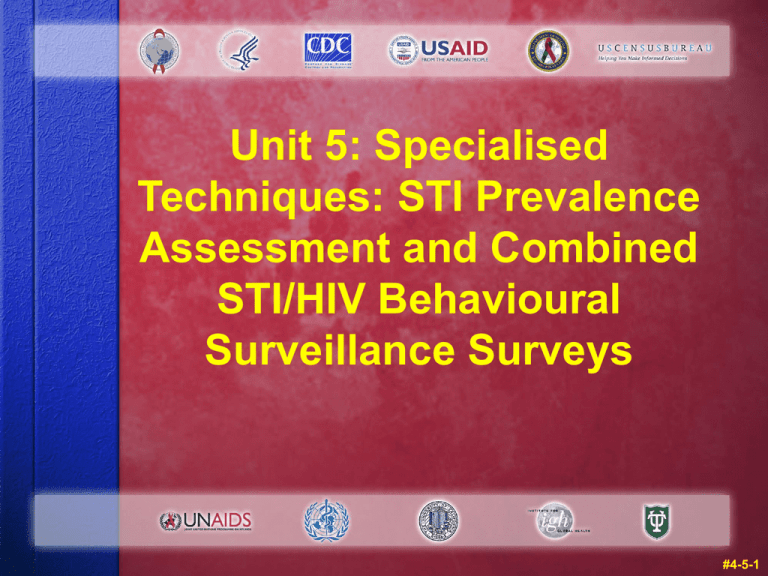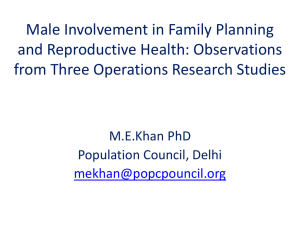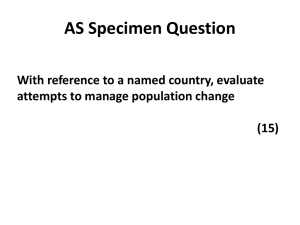
Unit 5: Specialised
Techniques: STI Prevalence
Assessment and Combined
STI/HIV Behavioural
Surveillance Surveys
#4-5-1
Warm Up Questions: Instructions
Take five minutes now to try the Unit 5 warm
up questions in your manual.
Please do not compare answers with other
participants.
Your answers will not be collected or graded.
We will review your answers at the end of the
unit.
#4-5-2
What You Will Learn
By the end of this unit you should be able to:
discuss the use of prevalence assessment in a
comprehensive STI surveillance system
discuss how STI sero-prevalence studies can
be linked to HIV sero-prevalence studies
discuss the assessment of STIs in serological
surveys
#4-5-3
What You Will Learn, Cont.
By the end of this unit you should be able to:
discuss how prevalence assessment studies
can be linked to behavioural surveillance
surveys
identify the STIs most suitable for inclusion in
combined STI/HIV behavioural surveillance
studies
#4-5-4
Prevalence Assessment and
Monitoring
A component of STI surveillance similar to seroprevalence surveys. It is either:
part of a combined HIV/STI behavioural survey
part of a national HIV sero-prevalence survey
a stand-alone project
STIs that are usually included are:
syphilis
gonorrhoea
chlamydia
#4-5-5
Choosing STIs for Behaviour
Surveys
Objectives:
Identify population sub-groups with high STI
prevalence
Monitor trends in STI prevalence among defined
populations
Uses:
Interventions (screening, treatment)
To obtain data for programme planning
Detection and treatment of STIs among routinely
screened populations (such as pregnant women)
#4-5-6
Definitions and Terms
Prevalence: proportion of people in a
population who have a disease or infection at
a specified time
Prevalence monitoring: following prevalence
trends over time to see if they are increasing
or decreasing
STI prevalence assessment and monitoring:
using surveys to determine what percentage
or how many people have STIs when
compared to the total population
#4-5-7
Programme Planning
STI prevalence data can be used to:
develop national estimates of STIs
identify population sub-groups at high risk for HIV
infection
guide funding and resource allocation for STI and
HIV prevention programmes
monitor effectiveness of STI and HIV prevention
programmes
intervene in the transmission of STI through
screening and treatment
#4-5-8
General Population Surveys
Serological screening among the general
population is usually done in:
Antenatal clinics, at least every two years
Blood donations, where anonymous STI data
should be passed to STI programmes
Routine testing is also done in:
Prisoners at entry to detention facilities
Military recruits
Routine sex worker examinations
#4-5-9
General Population Surveys, Cont.
These are usually relatively unbiased.
They are used to guide STI/HIV programmes.
These are different from surveys at sentinel
sites, which provide more complete data.
Types of tests that can be done include:
Sero-prevalence surveys for syphilis
Urine screening for chlamydia and gonorrhoea
Sero-prevalence surveys for herpes and hepatitis
#4-5-10
Figure 5.1. Calculating Prevalence
Calculating prevalence:
Prevalence =
Total number of patients who test
positive for a specific disease
Total number of patients tested
#4-5-11
Figure 5.2. Calculating Syndromic
Prevalence
Calculating syndromic prevalence (when
testing equipment is not available):
Syndromic
prevalence =
Total number of patients
displaying symptoms for a
specific disease
Total number of patients seen
#4-5-12
Analysis of STI Prevalence Data
Quarterly and annual trends should be analysed
overall and stratified by basic categories, such as:
Disease
Sex
Age group
Geographic location
Changes in prevalence may be due to:
Different types of clinics
Changes in health-seeking behaviours
Changes in selection criteria of patients
Changes in diagnostic tests
#4-5-13
Combined STI/HIV Behavioural
Surveillance Surveys
These surveys combine:
STI/HIV prevalence assessments –
measure the proportion of a population that
has a particular disease
behavioural surveys – use questionnaires
to examine the prevalence of behaviours
associated with HIV transmission
Combining surveys reduces costs.
#4-5-14
Goals of Combined STI/HIV
Behavioural Surveillance Surveys
Assess prevalence of asymptomatic STIs
Identify population sub-groups at high risk for HIV
Assess health-seeking behaviour for STI services
Measure the effectiveness of HIV/STI prevention
programmes
Determine the need for additional services
Guide funding and resource allocation
#4-5-15
What is Involved
Data elements for behavioural surveillance
include:
Number of sexual partners in past 3 or 12 months
New sexual partners in past 3 months
Condom use
Alcohol or drug use in past 12 months
Giving or receiving money for sex in past 12 months
Data collection for prevalence assessments is
done using blood or urine tests.
#4-5-16
Which STIs Should You Test For?
Factors to consider:
Laboratory infrastructure in country
Type of populations under study
The table on the following page describes
which STI testing is most appropriate for each
type of population sub-group.
#4-5-17
Table 5.1. Populations and STI
Monitoring
Population
STI
Comments
Low-risk (youth)
HSV-2, N. gonorrhoeae,
C. trachomatis
HSV-2 measures early
sexual exposure
Bridging and highrisk such as:
sex workers
truck drivers
injection drug users
N. gonorrhoeae, C.
trachomatis, H. ducreyi,
T. vaginalis
Measures recent
sexual exposure
T. pallidum
Exposure period
cannot be determined
unless titres are used
General population
N. gonorrhoeae, C.
trachomatis
Measures recent
sexual exposure
T. pallidum
Exposure period
cannot be determined
unless titres are used
#4-5-18
Data Elements
The data collected depends on population
surveyed. For example:
High-risk groups: more attention is given to
specific high-risk behaviours.
General population: demographic
characteristics, health-related behaviours
and general risk questions are given
priority.
Denominator data are also collected.
#4-5-19
Data Analysis
Initially analyse STI data separately:
Count gonorrohea and syphilis cases
separately.
Calculate prevalence and risk factors for
each disease separately.
Calculate prevalence according to
demographic variables for each disease
separately.
#4-5-20
Reporting Results of Special
Studies
People experienced in health
communications should design materials.
The report should be distributed to:
National AIDS/STI programme directors
District medical officers
Healthcare providers
Non-governmental organisations
Donors
Other public health agencies
#4-5-21
Types of Reports
Annual STI surveillance reports
Fact sheets for health department offices and clinics
Regular newsletters for clinicians and laboratory personnel
Press releases
Educational materials
Verbal feedback during meetings and supervisory visits
Electronic media
#4-5-22
In Summary
STI prevalence assessments can be used to monitor
STI prevalence trends in population sub-groups.
Combined STI/HIV and behavioural surveys allow
surveillance officers to calculate STI prevalence
among high-risk groups.
Selecting an STI for inclusion in a combined STI/HIV
behavioural surveillance study depends on the
population surveyed and laboratory infrastructure.
#4-5-23
Warm Up Review
Take a few minutes now to look back at your
answers to the warm up questions at the
beginning of the unit.
Make any changes you want to.
We will discuss the questions and answers in
a few minutes.
#4-5-24
Answers to Warm Up Questions
1. Prevalence ____________ is the
determination of prevalence among persons
screened in defined populations, while
prevalence monitoring is the determination of
trends in prevalence over time.
#4-5-25
Answers to Warm Up Questions
1. Prevalence assessment is the
determination of prevalence among persons
screened in defined populations, while
prevalence monitoring is the determination of
trends in prevalence over time.
#4-5-26
Answers to Warm Up Questions,
Cont.
2. True or false? STI prevalence data that show
high rates of STIs are used to identify
population sub-groups at high risk for HIV
infection.
#4-5-27
Answers to Warm Up Questions,
Cont.
2. True or false? STI prevalence data that show
high rates of STIs are used to identify
population sub-groups at high risk for HIV
infection. True
#4-5-28
Answers to Warm Up Questions,
Cont.
3. What is the primary purpose of STI
prevalence assessment and monitoring?
a. to identify population sub-groups with
high prevalence of STIs
b. to monitor trends in STI prevalence
among defined populations
c. a and b
d. none of the above
#4-5-29
Answers to Warm Up Questions,
Cont.
3. What is the primary purpose of STI
prevalence assessment and monitoring?
a. to identify population sub-groups with
high prevalence of STIs
b. to monitor trends in STI prevalence
among defined populations
c. a and b
d. none of the above
#4-5-30
Answers to Warm Up Questions,
Cont.
4. In an STI prevalence survey of the general
population, which STIs would you test for?
#4-5-31
Answers to Warm Up Questions,
Cont.
4. In an STI prevalence survey of the general
population, which STIs would you test for?
Gonorrhoeae, chlamydia, syphilis
#4-5-32
Answers to Warm Up Questions,
Cont.
5. True or false? Undertaking a combined
STI/HIV prevalence assessment and
behavioural surveillance survey can identify
population sub-groups at high risk for HIV
infection.
#4-5-33
Answers to Warm Up Questions,
Cont.
5. True or false? Undertaking a combined
STI/HIV prevalence assessment and
behavioural surveillance survey can identify
population sub-groups at high risk for HIV
infection. True
#4-5-34
Answers to Warm Up Questions,
Cont.
6. True or false? The choice of which STI to
include in a behavioural survey is made
independently of the type of population to be
studied.
#4-5-35
Answers to Warm Up Questions,
Cont.
6. True or false? The choice of which STI to
include in a behavioural survey is made
independently of the type of population to be
studied. False
#4-5-36
Answers to Warm Up Questions,
Cont.
7. True or false? STI prevalence data are
useful for monitoring the effectiveness of
HIV prevention programmes.
#4-5-37
Answers to Warm Up Questions,
Cont.
7. True or false? STI prevalence data are
useful for monitoring the effectiveness of
HIV prevention programmes. True
#4-5-38
Answers to Warm Up Questions,
Cont.
8. True or false? Combining HIV/STI
surveillance and behavioural surveillance
surveys is more cost effective than
conducting the two surveys separately.
#4-5-39
Answers to Warm Up Questions,
Cont.
8. True or false? Combining HIV/STI
surveillance and behavioural surveillance
surveys is more cost effective than
conducting the two surveys separately. True
#4-5-40
Answers to Warm Up Questions,
Cont.
9. What does X represent in the equation below?
Total number of patients who test
positive for a specific disease
Prevalence =
X
a. total number of patients who test negative for a specific
disease
b. total number of patients who test positive for all priority
diseases
c. total number of patients tested
#4-5-41
Answers to Warm Up Questions,
Cont.
9. What does X represent in the equation below?
Total number of patients who test
positive for a specific disease
Prevalence =
X
a. total number of patients who test negative for a specific
disease
b. total number of patients who test positive for all priority
diseases
c. total number of patients tested
#4-5-42
Small Group Discussion:
Instructions
Get into small groups to discuss these
questions.
Choose a speaker for your group who will
report back to the class.
#4-5-43
Small Group Reports
Select one member from your group to
present your answers.
Discuss with the rest of the class.
#4-5-44
Case Study: Instructions
Try this case study individually.
We’ll discuss the answers in class.
#4-5-45
Case Study Review
Follow along as we go over the case study in
class.
Discuss your answers with the rest of the
class.
#4-5-46
Questions, Process Check
Do you have any questions on the information
we just covered?
Are you happy with how we worked on Unit 5?
Do you want to try something different that will
help the group?
#4-5-47







